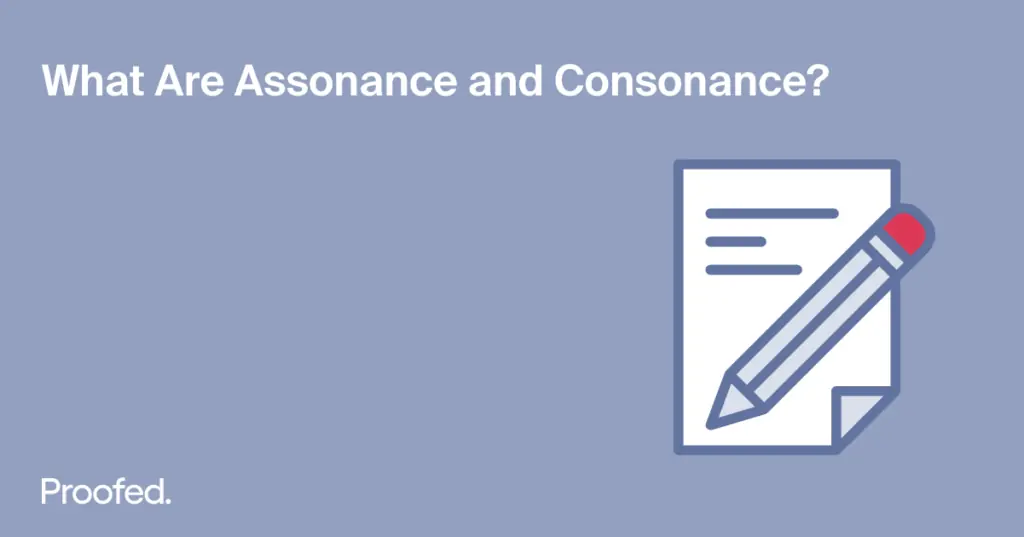Assonance and consonance are important parts of creative writing, especially poetry. Both involve repeating certain sounds, but what are they exactly? And when should you use them in your writing? This post will explain the basics.
What Is Assonance?
Assonance involves repetition of the same or similar vowel sounds in nearby words or sentences. This can create a sense of rhythm or musicality:
The early bird catches the worm.
Goodnight. Sleep tight. Don’t let the bedbugs bite.
Unlike regular rhymes (or perfect rhymes), this repetition of vowel sounds can occur anywhere in the words being linked, not just at their ends.
What Is Consonance?
Consonance involves the repetition of consonant sounds. As with assonance, this repetition can occur anywhere in the words being connected:
Curiosity killed the cat.
All’s well that ends well.
Consonance differs slightly from alliteration in this respect, as alliteration only refers to the use of repeated consonant sounds at the beginning of words.
What Are Assonance and Consonance Used For?
Assonance and consonance have three common uses:
- Introducing a sense of rhythm and playfulness in creative writing.
- Stressing a connection between ideas or words.
- Making a phrase or slogan more memorable.
They are most common in poetry and lyrics, but they are also used in prose. We’ll look at a few examples of both in the following.
Poetry and Lyrics
Assonance and consonance are commonly used in poetry and song lyrics as they help a piece flow well, making it more enjoyable for the reader or listener.
Rap music, for example, makes great use of both devices to add a strong sense of rhythm to lyrics, such as in Eminem’s “Lose Yourself”:
You better lose yourself in the music, the moment
You own it, you better never let it go
Find this useful?
Subscribe to our newsletter and get writing tips from our editors straight to your inbox.
Eminem repeats vowel and consonant sounds across these two lines to give a sense of urgency and rhythm, drawing the listener in.
These devices are often used similarly in poetry, but they can also be used for other effects. In a tongue-twister, for instance, assonance and consonance are used heavily to create a phrase that is hard to say or repeat. For example:
She sells sea-shells on the sea-shore.
The shells she sells are sea-shells, I’m sure.
For if she sells sea-shells on the sea-shore,
Then I’m sure she sells sea-shore shells.
Almost every sound in this verse involves assonance (e.g., the “-ee-” sound in “she” and “sea”) or consonance (e.g., the “sh-” sound in “she,” “shells,” “shore,” and “sure”)! This frequent repetition is what makes a tongue-twister hard to say.
Assonance and Consonance in Prose
In prose, assonance and consonance are often used to stress or link words and ideas. Take this line from Herman Melville’s Moby Dick, for instance:
Nearly all joined in singing this hymn, which swelled high above the howling of the storm.
This sentence repeats lots of “i,” “h,” and “s” sounds, adding a sense of musicality and linking the ideas of the hymn and the storm. This relationship between the human and natural realms becomes an important theme as the story develops.
More prosaically, you may see assonance and consonance a lot in advertising slogans, product names, and other memorable phrases. For example:
Gillette – The Best a Man Can Get
The repetition of vowel and consonant sounds in this short phrase makes it instantly memorable. Thus, if you’re trying to come up with a catchphrase, title, or slogan for something, you may want to play with repeated sounds like these.
Expert Proofreading
Techniques like assonance and consonance can add a new dimension to your creative writing. But whatever type of writing you do, making sure it is error free is important! Why not give our free proofreading trial a go to see how we can help?



